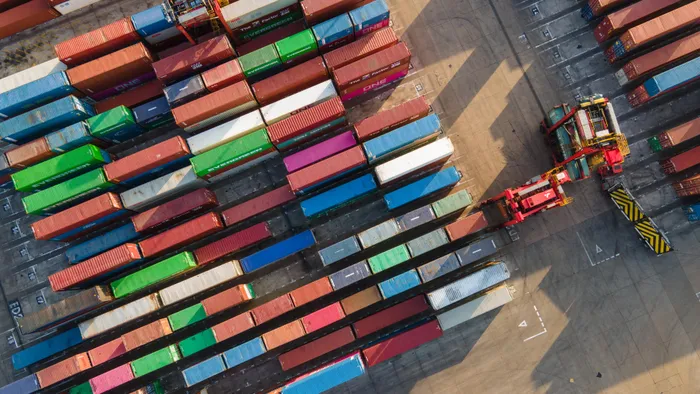Transnet Port Terminals achieves record container handling in turnaround efforts
LOGISTICS

Transnet Port Terminals (TPT) continues to make huge strides in its turnaround, with the Port Authority announcing this past week that they handled 100 158 twenty-foot equivalent units (TEUs) in a single week and 27 879 fully built units (FBU) across automotive
Image: supplied Transnet Port Terminals
Transnet Port Terminals (TPT) continues to show strong progress in its turnaround strategy, achieving record-breaking operational milestones that signal renewed efficiency across South Africa’s ports.
The state-owned logistics operator announced that it handled 100 158 twenty-foot equivalent units (TEUs) and 27 879 fully built automotive units (FBUs) in a single week — a major performance milestone that has been widely welcomed by industry experts.
In the same reporting period, Week 28, the Ngqura Container Terminal (NCT) surpassed its daily operational targets by 60%, handling 2 760 container moves in a single day — one of its best performances in years.
TPT CEO Jabu Mdaki said the results reflect a defining moment for the entity in the 2025/2026 financial year, which ends in March 2026.
“TPT has broken 14 performance records in the last six months across loading rates; daily, weekly and annual container and automotive volumes; as well as train turnaround times," he said.
"Some of the milestones were last seen 10 years ago, including exceeding the 100 000 TEU mark in a single week – which TPT has already achieved three times in the current financial year.”
Mdaki added that the operator has made major strides in closing performance shortfalls in key commodities, including magnetite and containers, as part of its operational recovery plan.
A major contributor to the improved performance has been the injection of new handling equipment across ports. This includes:
- Nine rubber-tyred gantry (RTG) cranes each for the Durban Pier 1 and Cape Town Container Terminals,
20 straddle carriers for Durban Pier 2,
A ship-to-shore crane for the Port Elizabeth Container Terminal, and
- Over 200 haulers and trailers distributed to container terminals countrywide.
“Focused maintenance has resulted in reduced breakdowns and increased uptime of equipment,” Mdaki said.
Maritime law expert Malcolm Hartwell, director and master mariner at Norton Rose Fulbright, said TPT’s recent achievements mark a turning point after years of decline under previous leadership.
“That committee, consisting of logistics experts in the private and public sectors, has been advising the government on steps to be taken to turn Transnet around,"Hartwell said.
"Arising out of those recommendations, Michelle Phillips was appointed as CEO in March 2024, having served within Transnet for 25 years. Phillips enjoys the support of the private sector and is attributed with much of the success Transnet has experienced in the last year.”
Hartwell added that the government finally realised that the monopoly held by Transnet over the ports and railway lines meant that Transnet is the most critical component within the logistics sector.
“Phillips and her board enjoy extensive political and private sector support. They are aware that investment in transport infrastructure delivers the highest return to the country’s economy and have launched a number of initiatives. Amongst the initiatives has been the creation of a separate company to manage Transnet rail infrastructure," he said.
"This, in turn, has allowed Transnet to invite private operators to operate trains on Transnet’s rail line in competition with Transnet Freight Rail and to reduce the logistics industry’s reliance on road haulage, which has caused extensive damage to and congestion on South Africa’s main highways."
Transnet has also accelerated licensing private terminals at key ports, including Durban’s largest container terminal, the fruit terminal and the multi-purpose terminal at Point Road, and the gas terminal in Richards Bay.
Hartwell also noted that heavy investment in new terminal equipment — including gantries and straddle carriers — has dramatically improved container handling capacity and turnaround times across the country’s ports.
“Treasury has extended guarantees for Transnet’s debt but refused any more bailouts. Saddled with an enormous debt, these initiatives have allowed Transnet to approach development and private institutions for funding. That funding is critical for capital investment and asset maintenance."
Ulrich Joubert, an independent economist, said Transnet’s leadership has clearly grasped the urgency of restoring the entity’s operational capacity.
“They know that they can only turn around this organisation if they really get going, get doing business again. They have to transport things. They have to move the containers through the harbours and the bulk," he said.
Joubert added that the recent focus on restoring throughput at ports and improving rail efficiency is a sign that management is tackling the fundamentals needed to restore business confidence.
"I'm of the opinion it's going to take a lot of time, but yes, at least you have to start somewhere."
BUSINESS REPORT